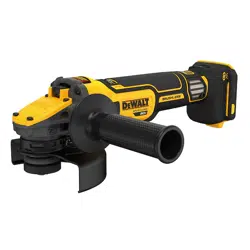Loading ...
Loading ...
Loading ...

50
ENGLISH
(Only use a locking flange if it is in perfect condition.) Refer
to Accessory Chart to see flangedetails.
6. To remove the wheel, reverse the aboveprocedure.
Mounting Sanding Backing Pads (Fig.G)
NOTE: Use of a guard with sanding discs that use backing pads,
often called fiber resin discs, is not required. Since a guard is
not required for these accessories, the guard may or may not fit
correctly ifused.
WARNING: Failure to properly seat the flange/ clamp nut/
wheel could result in serious injury (or damage to the tool
orwheel).
WARNING: Proper guard must be reinstalled for grinding
wheel, cutting wheel, sanding flap disc, wire brush or
wire wheel applications after sanding applications
arecomplete.
1. Place or appropriately thread backing pad
17
on
thespindle.
2. Place the sanding disc
18
on the backing pad
17
.
3. While depressing spindle lock
3
, thread clamp nut
16
on
spindle, piloting the raised hub on the clamp nut into the
centre of san ding disc and backingpad.
4. Tighten the clamp nut by hand. Then depress the spindle
lock button while turning the sanding disc until the sanding
disc and clamp nut aresnug.
5. To remove the wheel, grasp and turn the backing pad and
sanding pad while depressing the spindle lockbutton.
Mounting and Removing Hubbed Wheels (Fig.F)
Hubbed wheels install directly on the threaded spindle. Thread
of accessory must match thread ofspindle.
1. Remove backing flange by pulling away fromtool.
2. Thread the wheel on the spindle
4
byhand.
3. Depress the spindle lock button
3
and use a wrench to
tighten the hub of thewheel.
4. Reverse the above procedure to remove thewheel.
NOTICE: Failure to properly seat the wheel before turning
the tool on may result in damage to the tool or thewheel.
Mounting Wire Cup Brushes and WireWheels
(Fig.A)
WARNING: Failure to properly seat the flange/ clamp nut/
wheel could result in serious injury (or damage to the tool
orwheel).
CAUTION: To reduce the risk of personal injury,
wear work gloves when handling wire brushes and
wheels. They can becomesharp.
CAUTION: To reduce the risk of damage to the tool,
wheel or brush must not touch guard when mounted
or while in use. Undetectable damage could occur to
the accessory, causing wires to fragment from accessory
wheel orcup.
Wire cup brushes or wire wheels install directly on the threaded
spindle without the use of flanges. Use only wire brushes or
wheels provided with a threaded hub. These accessories are
Flanges and Wheels
Mounting Non‑Hubbed Wheels (Fig.F)
WARNING: Failure to properly seat the flange/ clamp nut/
wheel could result in serious injury (or damage to the tool
orwheel).
CAUTION: Included flanges must be used with depressed
centre Type 27and Type 42grinding wheels and
Type41cutting wheels. See the Accessory Chart for
moreinformation.
WARNING: A closed, two‑sided cutting wheel guard is
re quired when using cutting wheels.
WARNING: Use of a damaged flange or guard or fail ure
to use proper flange and guard can re sult in injury due to
wheel breakage and wheel contact. See the Accessory
Chart for moreinformation.
1. Place the tool on a table, guardup.
2. Install the backing flange
6
on spindle
4
with the raised
centre (pilot) facing the wheel. Press the backing flange
intoplace.
3. Place wheel
20
against the backing flange, centreing the
wheel on the raised centre (pilot) of the backingflange.
4. While depressing the spindle lock button and with the hex
depressions facing away from the wheel, thread the locking
flange
7
on spindle so that the lugs engage the two slots
in thespindle.
5. While depressing the spindle lock button, tighten the
locking flange
7
by hand or using the wrench supplied.
Adjusting the Guard
For guard adjustment, the guard release lever
9
engages
one of the alignment holes
15
on the guard collar using a
ratchetingfeature.
The engaging face is slanted and will ride over to the
next alignment hole when guard is rotated in a clockwise
direction (spindle facing user) but self-locks in the
anti-clockwisedirection.
Mounting the Guard (Fig.E)
1. Press the guard release lever
9
.
2. While holding the guard release lever open, align the
lugs
13
on the guard with the slots
14
on the gearcase.
3. Keeping the guard release lever open, push the guard down
until the guard lugs engage and rotate them in the groove
on the gear case hub. Release the guard releaselever.
4. With the spindle facing the operator, rotate the guard
clockwise into the desired working position. Press and
hold the guard release lever
9
to rotate the guard in the
anti-clockwisedirection.
NOTE: The guard body should be positioned between
the spindle and the operator to provide maximum
operatorprotection.
The guard release lever should snap into one of the
alignment holes
15
on the guard collar. This ensures that
the guard issecure.
5. To remove the guard, follow steps 1–3 of these instructions
inreverse.
Loading ...
Loading ...
Loading ...
